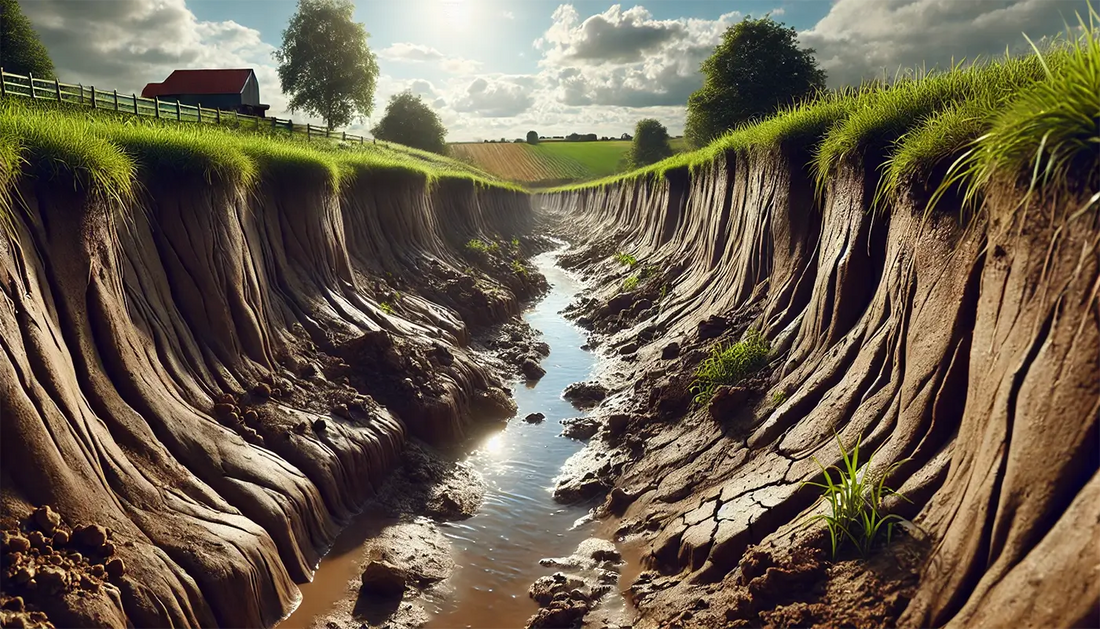Imagine a garden where the earth beneath your feet stays healthy, thriving, and intact. Soil erosion can be a silent thief, gradually sweeping away the fertile ground essential for your plants’ growth.
But what if you could prevent this naturally, without the need for harsh chemicals? In this guide, you’ll discover simple, effective techniques to stop soil erosion organically. These methods not only protect your garden but also contribute to a healthier environment.
Are you ready to learn how you can keep your garden soil where it belongs and ensure a flourishing green space for years to come? Let’s dig into the secrets of preserving your precious soil naturally.
Natural Ground Cover
Organic methods can prevent soil erosion effectively. Natural ground cover, like grass and shrubs, holds soil firmly in place. These plants act as barriers, reducing runoff and protecting against erosion.
Natural ground cover is a powerful ally in the fight against soil erosion. It acts as a protective layer that shields the soil from harsh weather and helps retain moisture. Plus, it adds beauty to your landscape, transforming a barren plot into a lush, green paradise.Understanding The Benefits Of Natural Ground Cover
Natural ground covers like grass, clover, and wildflowers offer more than just visual appeal. They help bind the soil with their roots, reducing the risk of erosion. These plants also improve soil health by adding organic matter and enhancing nutrient cycling.Choosing The Right Ground Cover For Your Area
Selecting the appropriate ground cover depends on your climate, soil type, and the specific needs of your garden. In my own backyard, I found that hardy native plants like creeping thyme and sedum worked wonders. They not only thrived in the local conditions but also attracted beneficial insects.How To Plant Ground Cover Effectively
Planting ground cover is straightforward. Start by clearing the area of weeds and debris. Then, evenly distribute seeds or young plants across the surface. Ensure they have enough space to spread and cover the ground entirely as they grow.Maintaining Your Natural Ground Cover
Regular maintenance is key to ensuring your ground cover thrives. Water them during dry spells and prune as needed to prevent overgrowth. I once neglected this step, and my garden turned into a wild jungle, making it less effective against erosion.Can Ground Cover Be Cost-effective?
Absolutely. Ground cover plants are generally low-maintenance and require fewer resources over time. Consider the cost savings on water and fertilizers compared to traditional lawns. Plus, they reduce the need for synthetic erosion control methods. Do you have a patch of soil that needs saving? Why not try natural ground cover and witness the transformation? It’s an eco-friendly, beautiful way to protect your land and nurture biodiversity.
Terracing Techniques
Terracing techniques offer a natural way to combat soil erosion. These methods reshape the land to prevent water runoff. They are ideal for sloped areas where erosion is a problem. By creating levels on a slope, terracing slows water movement. This helps water soak into the soil instead of washing it away.
What Is Terracing?
Terracing transforms a sloped landscape into a series of steps. Each step acts as a barrier to slow down water. This reduces the speed and strength of water, protecting the soil.
Benefits Of Terracing Techniques
Terracing holds soil in place. It prevents the loss of nutrients vital for plant growth. It also reduces the risk of landslides, making areas safer. Terracing promotes better water retention in the soil. This leads to healthier plants and crops.
How To Create Terraces
Start by assessing the slope of your land. Determine the number of terraces needed. Mark out the terraces using stakes and string. Dig into the slope to form flat surfaces. Reinforce each terrace with stones or plants to stabilize them.
Using Plants To Stabilize Terraces
Plant roots anchor soil and prevent erosion. Choose native plants for your terraces. They adapt well and require less maintenance. Their roots grow deep, offering strong soil support.
Maintaining Terraced Land
Regularly check terraces for signs of erosion. Repair any damaged areas promptly. Ensure plants are healthy and thriving. Remove weeds that compete with terrace plants. This keeps terraces strong and effective.
Compost And Mulch Use
Prevent soil erosion naturally with compost and mulch. Compost enriches soil, enhancing its ability to retain water. Mulch protects the surface, reducing water runoff and preserving soil structure. Together, they create a barrier against erosion while nourishing the earth.
Compost and mulch are like nature’s superheroes in the fight against soil erosion. They work together to enrich the soil, retain moisture, and protect the land from the ravages of wind and water. By using compost and mulch, you not only improve soil quality but also play a vital role in preserving the environment. These organic methods offer practical and sustainable solutions for preventing soil erosion in your backyard or farm.What Is Compost?
Compost is decomposed organic matter. You can make it from kitchen scraps, yard waste, and other biodegradable materials. When added to the soil, compost enriches it with nutrients. Composting is easy to start at home. All you need is a bin and a mix of green and brown materials. Turn the pile regularly to speed up the decomposition process.The Benefits Of Using Compost
Compost improves soil structure and increases its water-holding capacity. This helps prevent soil erosion by reducing runoff. It also adds essential nutrients to the soil, promoting healthier plant growth. Healthy plants with strong roots anchor the soil, reducing erosion risks.Understanding Mulch
Mulch is a layer of material spread over the soil surface. It can be organic, like straw or leaves, or inorganic, like stones or plastic. Organic mulch decomposes over time, adding nutrients to the soil. Inorganic mulch is good for long-term coverage.How Mulch Helps Prevent Soil Erosion
Mulch acts as a protective barrier for the soil. It reduces the impact of raindrops, preventing soil particles from being washed away. It also helps regulate soil temperature and retains moisture, promoting healthy plant growth. This, in turn, helps keep the soil in place.Practical Tips For Applying Compost And Mulch
Apply a layer of compost to your garden or field before planting. This enriches the soil and prepares it for healthy plant growth. Cover the soil with a layer of mulch, about 2-3 inches thick. This will help retain moisture and protect against erosion.Personal Experience: The Impact Of Compost And Mulch
I once struggled with soil erosion in my vegetable garden. The heavy rains would wash away the topsoil, leaving my plants struggling. After using compost and mulch, the difference was remarkable. The soil stayed put, and my plants thrived, proving the effectiveness of these organic methods.Questions To Consider
Have you tried using compost and mulch in your garden? What changes did you notice in your soil and plant health? Could these methods be the key to solving soil erosion problems in your area? Try them out and see the difference for yourself.
Planting Perennial Vegetation
Planting perennial vegetation is a natural way to combat soil erosion. Perennials are plants that live for more than two years. They have deep root systems that hold soil firmly. These roots protect against water and wind erosion. By planting perennials, you create a stable environment for your garden or land. This method is eco-friendly and sustainable.
Benefits Of Perennial Vegetation
Perennial plants improve soil health over time. Their roots break up compacted soil, enhancing water infiltration. This reduces runoff and erosion. Perennials also provide year-round ground cover. This protects soil from harsh weather conditions. Their continuous growth cycle eliminates the need for annual planting. This saves time and resources.
Choosing The Right Perennials
Select perennials suited to your local climate. Native plants adapt better and require less care. Consider the soil type in your area. Some perennials thrive in sandy soil, others in clay. Research plant needs before planting. This ensures healthy growth and effective erosion control.
Planting Techniques For Success
Space perennials strategically to maximize soil coverage. Group plants with similar water and sunlight needs. This promotes efficient growth. Mulch around plants to retain moisture and reduce weeds. Regularly check plant health and remove dead leaves. This encourages new growth and maintains soil protection.
Maintenance And Care
Water perennials during dry spells to support their growth. Prune plants to maintain shape and encourage new shoots. Fertilize with organic compost to enrich the soil. Check for pests and treat naturally to avoid chemicals. Proper care ensures long-lasting soil protection.

Conclusion
Preventing soil erosion organically is vital for healthy land. Simple steps make a difference. Plant cover crops to protect soil. Mulch helps retain moisture and prevents erosion. Terracing on slopes controls water flow. Compost enriches soil and boosts its strength.
Rotate crops to maintain soil balance. These practices enhance land’s resilience. Choose sustainable methods for a greener future. Healthy soil sustains plant life and promotes biodiversity. Small changes lead to big benefits. Protecting soil ensures long-term productivity. Embrace organic methods to preserve soil for generations.
The earth thanks you for your efforts.

